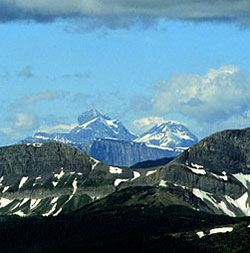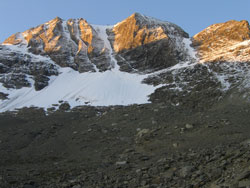
Looking south-south west to Mount Harrison from KP 8 of the Bull River Road (courtesy Dan Ronsky)
Mount Harrison
- 3359 m (11,021ft)
- First Ascent
- Naming History
Located south of the head of the Bull River and east of the head of Thunder Creek
Province: BC
Headwater: Kootenay
Ascent Party: W. Himmelsback, R. Hutchinson, J. Hutton, D. MacLaurin, B. Moss, P. Sherman
Named for: Harrison, Francis A. DFC (From Cranbrook, BC, F.A.Harrison was with 428 Squadron RCAF when he was killed during WW II. P/O Harrison was an airgunner aboard a Lancaster bomber (KB780) that was attacking Duisburg when it was hit and crashed in Obermeiderich
Introducing his article in the 1965 Canadian Alpine Journal, "The Unexpected 11,000 Footer," Paddy Sherman wrote, “It was a little hard to believe at this stage of development in the Rockies, but it was definite: an unexpected 11,000 –footer had reared its head in a region where everyone “knew” there were no high peaks. . . Since 1930, J. Monroe Thorington's 'A Climbers Guide to the Canadian Rockies' had read: "So much is now known of Canada’s Rocky Mountains that no new peaks above 11,000 feet are likely to be discovered." Sherman's article went on to describe his party's first ascent of the mountain. Mount Harrison was both named, and first climbed in 1964, some 34 years after what was throught to be the last of the 11,000 footers, Mount Andromeda, was climbed. The outstanding photo by Marty Dewis was taken from Pasque Mountain using a 210 mm telephoto lens. It shows Mount Harrison looming 35 km to the west of the ridge that forms part of the High Rock Range, just to the north of Mount Gass. A high (10,450 feet), un-named outlier to Mount Harrison lies 4.5 km to the ENE and is seen to the right of Mount Harrison in the photo. In his article in the Canadian Alpine Journal, Sherman refers to the top 400 feet or so of the southeast ridge as, “one vast overhang.” This shows up very well in Marty Dewis's photo. The following details regarding P/O Harrison's career with the Royal Canadian Air Force, including the citation that accompanied the awarding of the Distinguished Flying Cross is taken from the website of the Airforce Association of Canada (courtesy Hugh Halliday) HARRISON, WO (now P/O) Francis Arthur (J88062) - Distinguished Flying Cross - No.428 Squadron - Award effective 3 October 1944 as per London Gazette of that date and AFRO 2637/44 dated 8 December 1944. Born 1917 in Cranbrook, British Columbia; home in Vancouver. Enlisted in Calgary, 19 January 1942. Trained at No.4 ITS (graduated 3 July 1942) and No.3 BGS (graduated 25 September 1942). "As rear gunner Warrant Officer Harrison has completed numerous sorties, involving several minelaying missions and attacks on railway sidings and other heavily defended positions. Recently he was detailed for an operation in the Caen area. On the return flight his aircraft was engaged by a fighter but Warrant Officer Harrison drove it off. A little later another fighter closed in. Warrant Officer Harrison opened fire to good effect and the enemy aircraft burst into flames and fell to the ground where it exploded. This airman has invariably displayed great coolness and courage in action." HARRISON, WO (now P/O) Francis Arthur (J88062) - Distinguished Flying Cross - No.428 Squadron - Award effective 3 October 1944 as per London Gazette of that date and AFRO 2637/44 dated 8 December 1944. Born 1917 in Cranbrook, British Columbia; home in Vancouver. Enlisted in Calgary, 19 January 1942. Trained at No.4 ITS (graduated 3 July 1942) and No.3 BGS (graduated 25 September 1942). "As rear gunner Warrant Officer Harrison has completed numerous sorties, involving several minelaying missions and attacks on railway sidings and other heavily defended positions. Recently he was detailed for an operation in the Caen area. On the return flight his aircraft was engaged by a fighter but Warrant Officer Harrison drove it off. A little later another fighter closed in. Warrant Officer Harrison opened fire to good effect and the enemy aircraft burst into flames and fell to the ground where it exploded. This airman has invariably displayed great coolness and courage in action."



